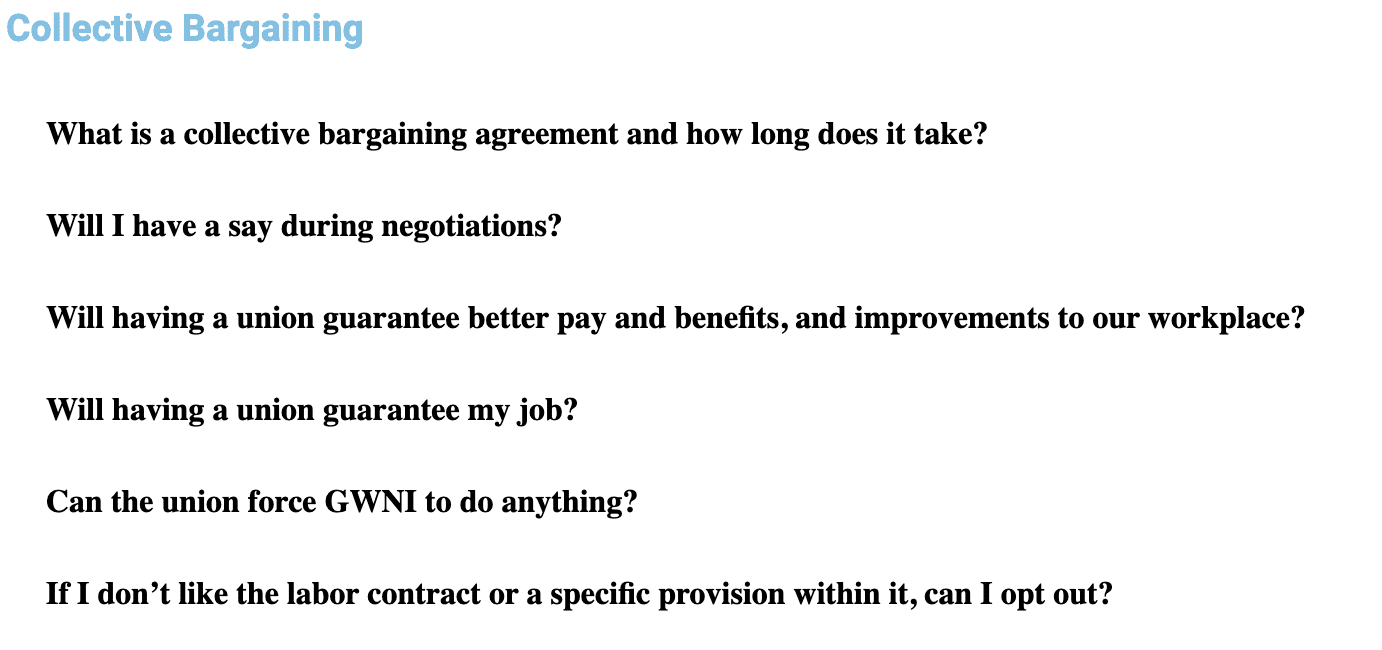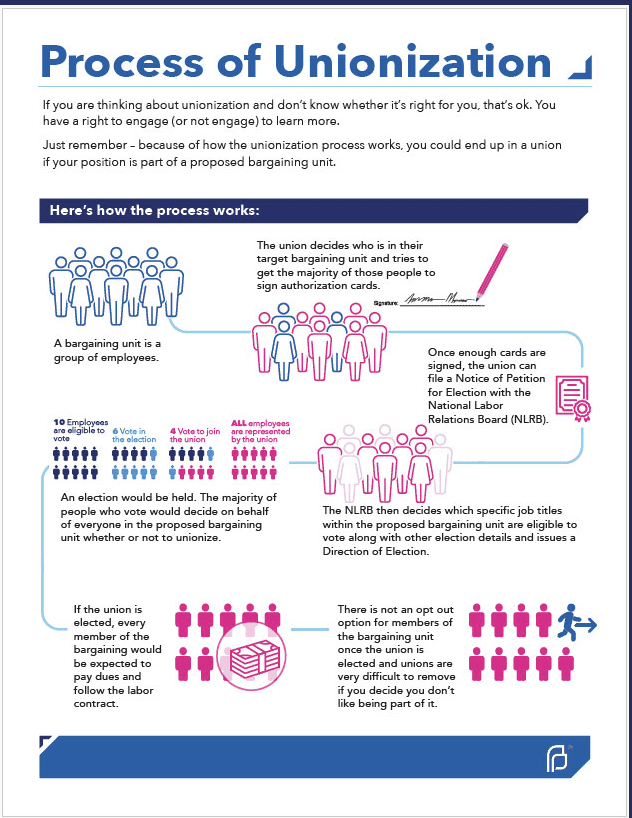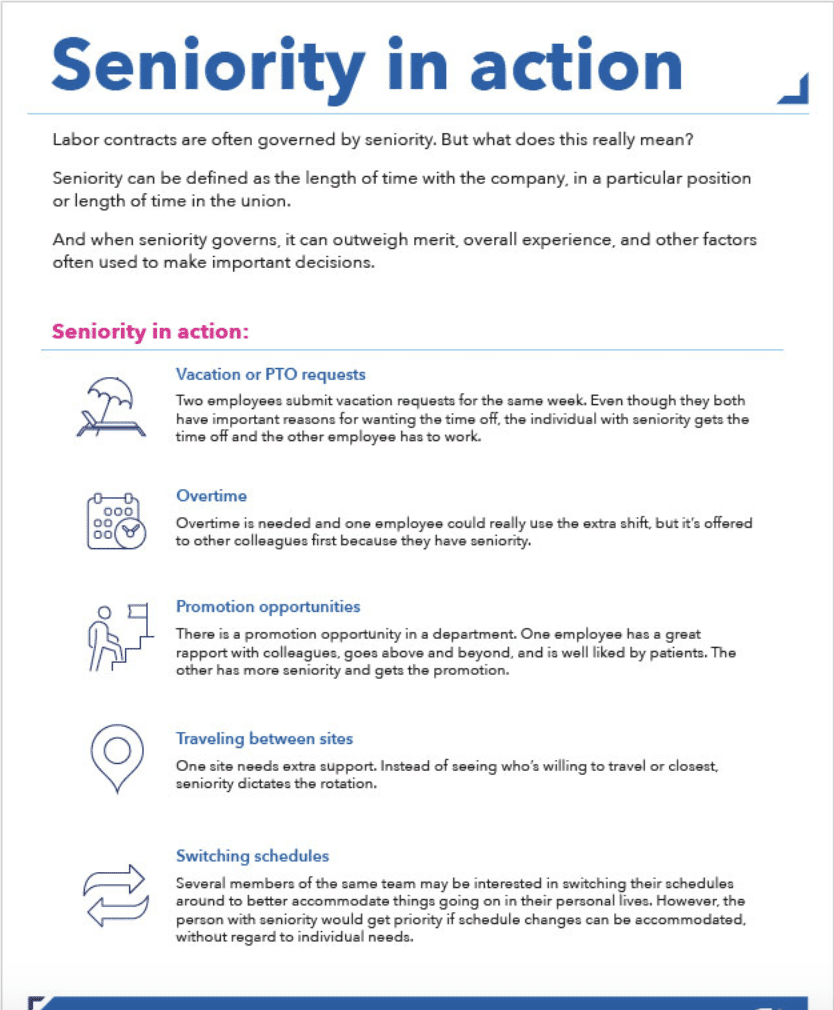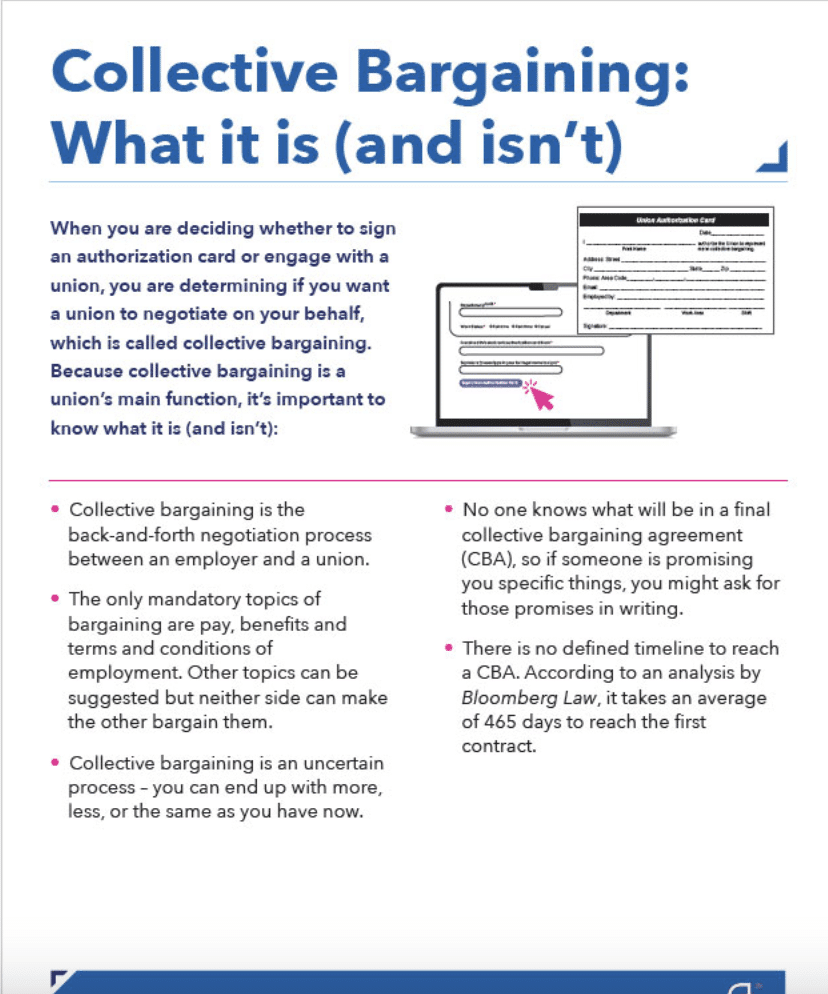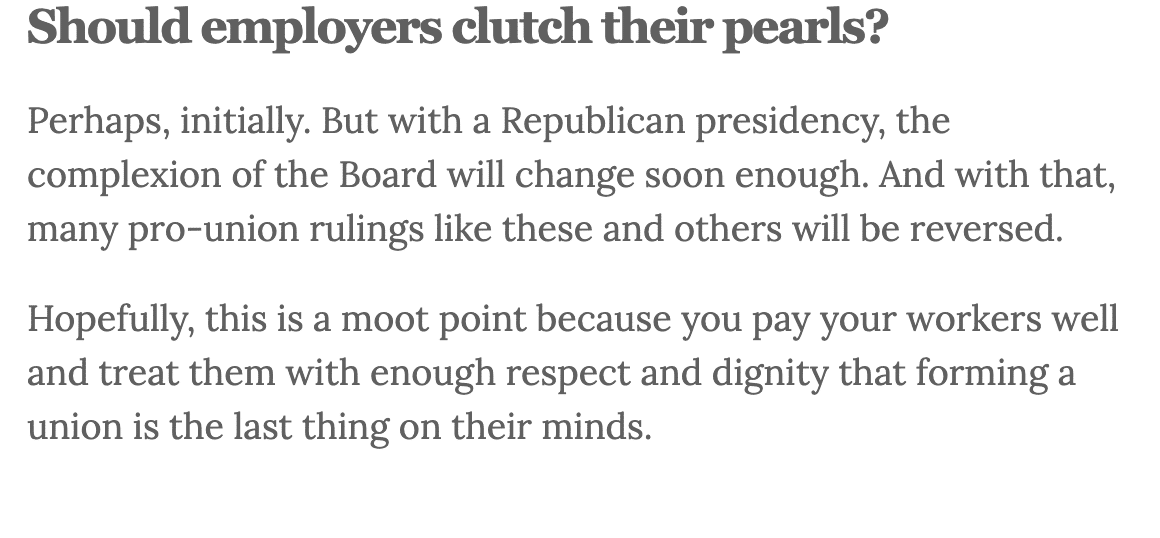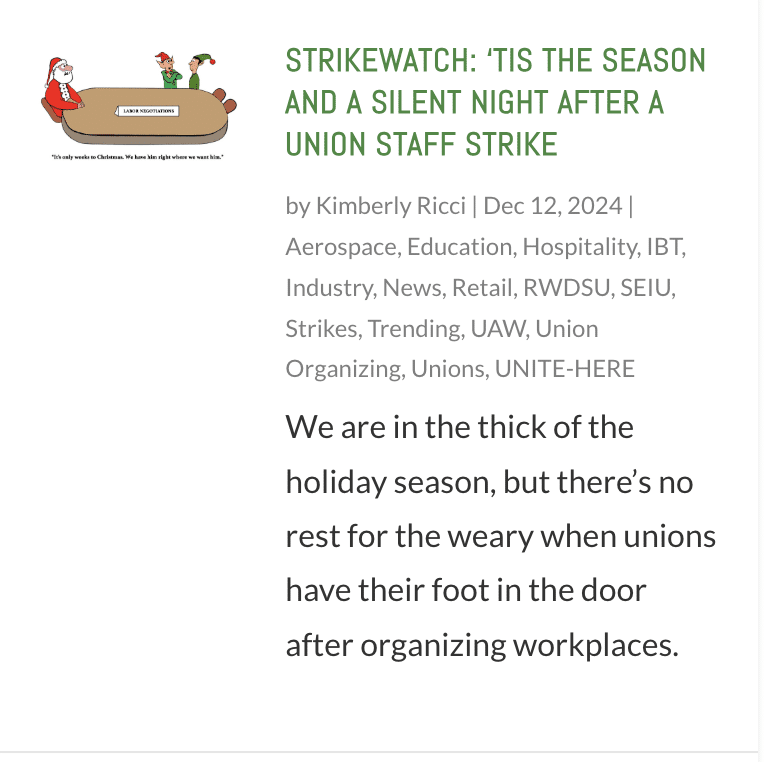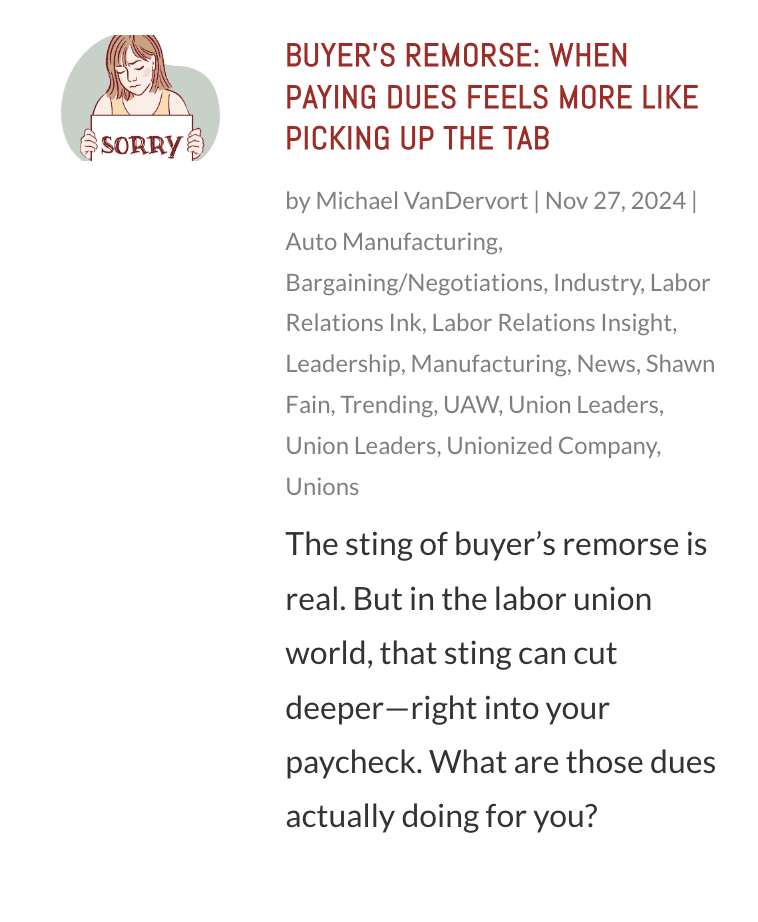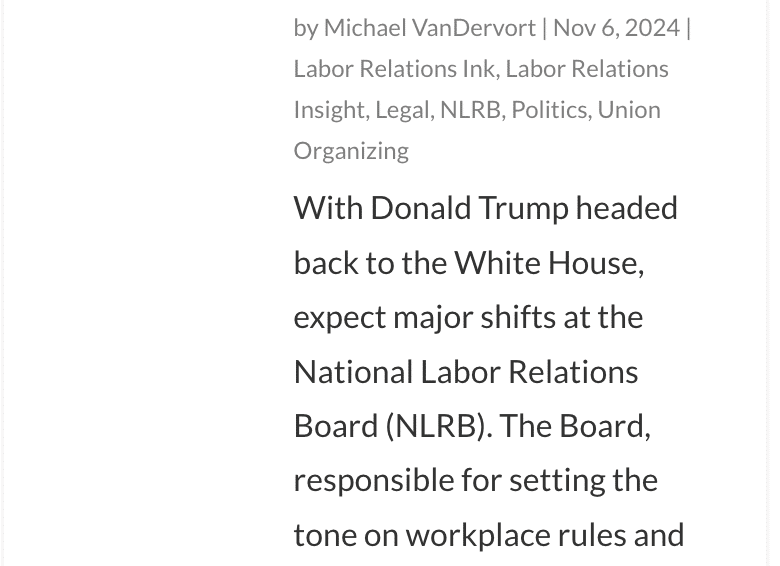Employees support Planned Parenthood, ‘But the mission doesn’t pay the bills.’
Employees at the local Planned Parenthood are considering unionization over what they characterize as low pay and bad working conditions. The CEO is paying a union-busting firm the equivalent of 17 medical assistants’ hourly wages to persuade them not to.

News story by Erin Sellers | RANGE Media
Editor’s note: The reporter of this story has a friendship with one of the sources. Per our policy on community journalism, developed in conjunction with our Advisory Board, we hired an editor from outside of the RANGE team to edit the story for both content and potential bias.
Planned Parenthood of Greater Washington and Northern Idaho has a long track record of providing reproductive healthcare, including abortions, across our region and a reputation as fierce defenders of bodily autonomy and the right to choose.
In recent years, though, the organization — which is made up of 11 clinics located mostly in Eastern and Central Washington — has expanded its advocacy to include voter registration drives, Know Your Rights training for Latino/x/e farmworkers and lobbying the state government to raise the minimum wage. But last month, executive leadership at Planned Parenthood of Greater Washington and Northern Idaho (commonly abbreviated to PPGWNI), made it clear their advocacy for workers’ rights had limits.
In early November, Karl Eastlund, PPGWNI’s CEO, contracted with the Labor Relations Institute (LRI), an organization that calls itself one of the oldest “labor relations” consultants in the country and has been described as “Corporate America’s Favorite ‘Union Busting’ Firm.”
For over a year, Eastlund’s rank-and-file employees have been organizing to unionize PPGWNI.
Eastlund is paying LRI $425 an hour to try to talk them out of it.
According to forms filed with the federal Office of Labor Management Standards, the contract between PPGWNI and LRI Consulting Services (the arm of LRI that contracts directly with employers), began on Nov. 12 with a series of three hour-long informational meetings employees were told to attend. It is an ongoing contract with no firm end date and no maximum cost.
This wasn’t the beginning of PPGWNI’s union-busting efforts: one middle manager currently working for PPGWNI told RANGE that they were forced to spend over 40 hours from June to October in meetings with what was described to them as a “public relations professional.” In those meetings, they said they were repeatedly pressed about whether or not subordinates had brought up questions about their labor rights, and were given talking points on how to dissuade employees from unionizing.
Prior to hiring LRI, leadership also sent out an email directing employees to a Planned-Parenthood-branded website full of anti-union language that was supposed to inform them about unions. (That site has been pulled down but RANGE reviewed screenshots and page freezes from October created by our old friend, the Way Back Machine).
“At GWNI, our mission is rooted in the right to choose, and this extends beyond our patients, to each of you,” Eastlund wrote in the all-staff email that RANGE obtained.
But for a chorus of current and former staff members RANGE has spoken with in the last week, Eastlund’s message rang hollow. Each told remarkably similar stories of unfair and unequal pay, long work days with limited or no breaks, a manipulative workflow and a payscale that relied on underpaying medical assistants and forcing higher-paid clinicians to see a new patient every 15 minutes. If employees spoke up, they were taught to expect reprimands, retributive demotions or, in the worst cases, termination.
Eastlund didn’t respond to requests for comment for this story, but Clover Simon, Vice President of PPGWNI, said in a statement sent to RANGE, “We are proud to pay our employees competitive wages and benefits that are consistently above market. Our staff have received raises and bonuses each year for the past seven years. The employee turnover at PPGWNI is exceptionally low, especially when compared to other health care organizations.
“We also believe every employee has the right to decide whether or not to be represented by a union. We believe employees have a right to make informed decisions when independently considering contractual agreements that could have an impact on their work environment.”
The rank and file want a union
Planned Parenthood staff we spoke with say this culture of fear has been around a long time, and one clinician said proto-union efforts — like a group text where clinicians swapped stories and shared their pay rates in order to help their colleagues negotiate raises — had existed for years. A series of events in 2022 and 2023, though, finally raised the temperature to a boiling point. Informal solidarity wasn’t cutting it anymore. The rank and file of PPGWNI wanted a union.
Roe v. Wade fell in June of 2022, causing an increase in patients, an increase in stress as employees found themselves targeted by harassment and an increase in fears that providing abortions in Washington to out-of-state patients could end in prosecution for clinicians and medical assistants alike.
In 2022, CEO Eastlund told The Sightline Institute that without additional funding, the organization might be forced to reduce preventive care, primary care and mental health services in order to meet the urgent need for abortion healthcare.
But within a year, Eastlund’s pay had jumped by $100,000, the end of a series of increases that saw his compensation more than double between 2019 and 2023.
As Eastlund’s career was on a meteoric rise, employees who were becoming increasingly vocal about the poor working conditions slowly got pushed out.
First, it was Sarah Dixit, who left after being told to take on a supervisor’s work with no additional pay. Next, the traveling Raiz clinics, which provided life-saving medical care to migrant farmworkers across the state, were quietly killed, and the employees in charge of them demoted. Two beloved clinicians were fired after speaking up about a discrepancy in pay between white and BIPOC clinicians. And, in the middle of 2023, current Spokane City Council Member Paul Dillon — then the vice president of Public Affairs who employees said shielded them from toxicity in upper management — was demoted right before taking paternity leave. He was told it was because leadership had new concerns about him potentially holding public office while working in advocacy for the organization. His new role took him out of upper management and his pay was slashed.
Experts we spoke with said it’s common for companies to try to promote union agitators into management so that they can no longer agitate, since managers are excluded from participating in unions. PPGWNI had just demoted one of its most vocal pro-labor leaders to a member of the rank and file.
Within a few months of winning his election, Dillon resigned, but not before helping make initial connections with one of Spokane’s most hard-charging unions. On his last day of work, he memorialized the end of his time at Planned Parenthood with photos on social media of Cathy McMorris Rodgers’ Spokane office lit up by the words “I stand with PP” and one word of public advice to the colleagues he left behind:
“Unionize.”
‘Understaffed, underpaid, overworked.’
Working at Planned Parenthood had been a dream for Madeline. When she decided to go into medicine, her first and only application to a medical assistant position was at PPGWNI. When they offered her the job, she was thrilled.
She was drawn in by the organization’s mission: its stated values of reproductive freedom, justice and bodily autonomy for all, Madeline told RANGE. Her belief in the mission helped offset the $19 an hour pay — less than some of her peers were making at McDonald’s at the time — and certainly less than most medical assistants in Spokane were paid.
“I had this picture in my head of what Planned Parenthood was supposed to be,” Madeline said. Her vision for the job was a group of people committed to a cause, the emotionally demanding work offset by the sense of mission and purpose. At no point, she told RANGE, did she imagine “an understaffed skeleton crew with very few medical assistants where labor laws were being broken,” but that was the reality she said she walked into: “understaffed, underpaid, overworked.”
Every single employee we interviewed, current and former, stressed that the medical assistants and entry-level staff members at PPGWNI were underpaid compared to competitive market rates. A search of available medical assistant jobs at comparable clinics across the state like Cedar River and medical facilities in Spokane shows that $19 an hour is lower than almost every other option.
Madeline got a raise last year and is now making a few bucks more an hour.
The pay bump has been helpful, but it can’t offset the things Madeline has said she has seen, which include termination of providers who spoke up against racist pay disparities and poor working conditions. She has become a key part of unionization efforts at PPGWNI. (Because Madeline is a current employee who fears termination as retaliation for union activity, we are using a pseudonym to protect her identity.)
Simon, the vice president of Human Resources at PPGWNI, said the turnover rate for medical assistants and healthcare assistants at PPGWNI is 14.5%, while the overall turnover rate at PPGWNI is 11%.
Almost all of the current and former employees we talked to described the same phenomenon: working at Planned Parenthood was a dream-turned-nightmare.
“It was my first job out of college and I thought ‘I could stay here forever,’” Dixit, the former Public Affairs manager for the organization, told RANGE.
For a few years, her job was closer to the fairytale she imagined. On Paul Dillon’s team, she lobbied Washington and Idaho lawmakers for policies to protect bodily autonomy, worked with area high school and college students to teach them how to advocate for themselves, and helped coordinate the Raiz clinics that connected migrant farmer-worker communities with Planned Parenthood clinicians who could treat their basic needs.
Right after the fall of Roe v. Wade, Dixit and others on her team were abruptly told by the CEO that they needed to “hone in on issues that were directly applicable for reproductive health,” Dixit said. No more fighting for the state to raise the minimum wage, no more pushing for gender affirming care, no more facilitating direct services for under-served communities like farmworkers. Just abortion access and sex education all the time.
There had been other “small cuts,” along the way, but Eastlund’s push to stop fighting on any intersectional fronts besides reproductive rights was the biggest injury. And, Dixit said, it was made worse by the timing of Dillon’s paternity leave; he wasn’t there to protect or fight for Dixit and their team.
Dixit and two other peers were told to split Dillon’s former duties in addition to their own with no additional pay. This wasn’t standard; Dillon told RANGE that in the past, when managers had gone on leave, the employees absorbing their job duties also received a temporary pay increase. Dillon had been under the impression that it would be the same for the employees taking on his duties.
The additional stress with no added pay pushed Dixit over the edge. Shortly after, she started looking for another job.
Belt-tightening for thee, raises for me
Meanwhile, as many of the medical assistants were making sub-fast-food wages and Dixit and her team were absorbing the duties of a former vice president (who had made $120,000 per year) with no additional pay raise, PPGWNI CEO Eastlund, and to a lesser extent, his executive team, had been consistently getting raises for years.
In 2019, Eastlund was PPGWNI’s second-highest paid employee, making over $234,000 in total compensation, just behind Denise Bayuszik, the organization’s chief medical officer, who made a little over $275,000, according to the organization’s annual tax filings.
By 2020, Eastlund was making over $363,000 in total compensation, a more than 50% leap from the prior year.
Despite stressing that the priority of PPGWNI moving forward should be medical services, Eastlund — who creates the budgets for the organization — was not as generous with his chief medical officer. Bayuszik got a much smaller raise, to around $288,000.
2021 had little change in Eastlund’s salary and 2022 brought him close to almost exactly $400,000 in total compensation.
Last year, he inked another big jump, bringing his salary to $460,356 and other compensation to $29,550 — another nearly $100,000 jump in pay.
Despite seeing a massive increase in patients, responsibility and legal threats after the fall of Roe v. Wade, Bayuszik’s salary had only increased to $312,139 in that time. With other compensation at less than $25,000, Bayuszik now made about $164,000 less than Eastlund.
These gaudy raises didn’t go unnoticed by staff like Dixit, who says she had to fight hard for even small raises. Simon, the PPGWNI spokesperson, said “staff have received raises and bonuses each year for the past seven years.” Managers we talked to said many of those yearly raises were just 3% cost-of-living-adjustments.
Letting the dream die
It wasn’t long before Dixit found a job doing nearly identical advocacy work for more pay at Pro-Choice Washington, a statewide organization.
Even on her way out the door, Dixit had to deal with one last heartbreak: Despite it all, she still loved her team and believed in her work. She didn’t really want to leave. Through her supervisor, she asked Planned Parenthood if they would consider matching the offer she had just received from Pro-Choice Washington.
The answer relayed through her supervisor was short and to-the-point: no.
She put in her resignation letter the same day. Within a few days, everyone who had been on her team was demoted from managers to organizers.
Previously, Faviola Lopez held the title Public Affairs manager. She was demoted to “community organizer” in June of 2023.
The title change for current City Council Member Lili Navarrete, who claimed in her resignation email that she was demoted “without a justified explanation,” moved her from director of Public Affairs to organizer. Further rubbing salt in that wound, she wrote, later that year “my position as director of Public Affairs was posted with a higher salary while I was on [Family Medical Leave].” Navarrete declined to comment for this story.
“The people who work at Planned Parenthood really believe in the mission. You know you’re doing the good work and that makes it worth it,” Dixit said. “[But] when management doesn’t treat you with dignity and respect it becomes a heartbreaking place to work in.”
“Yes, the mission is important and that’s why a lot of us chose to work there,” Dixit added, “But the mission doesn’t pay the bills.”
Further down the corporate ladder, the poorly paid medical assistants and higher-paid clinicians alike told us that the way the work was structured led to stress, burnout and high turnover.
Two former clinicians told us they were expected to cycle through four clients every hour — one appointment every 15 minutes — which left much of the patient care burden on medical assistants like Madeline. And yet, those assistants “were paid like dirt,” one clinician said.
Laura, a former clinician at PPGWNI, worked at the Planned Parenthood affiliate for four years. Laura spoke on condition that we use a pseudonym because “there is a culture of retaliation from PPGWNI, and this is a small, reputational field.”
Unlike some of her peers who applied with rose-colored glasses on, Laura went in with her eyes wide open. Before she applied, friends who had previously worked there warned her about a toxic culture and poor working conditions.
Still, she didn’t expect it to be quite as bad as it turned out to be.
Laura said that, throughout her tenure, it was common to hear via corporate email that a medical assistant had been fired or quit that day, sometimes even during their shift. Laura watched a favorite medical assistant “get forced out by the administrative staff because she would stand up for herself and her patients,” and was unable to do anything to protect her.
“It does no service to the [reproductive health] movement to chew up and spit out workers,” Laura told RANGE. She described her former coworkers at PPGWNI as “lovely, mission-driven people,” and the administration as “a bunch of evil hyenas.”
Laura, and another clinician who spoke to RANGE under the pseudonym Charlotte — citing similar concerns as Laura — were both part of the informal clinician network that communicated about pay transparency and working conditions with their peers across the 11 clinics. When Laura first started, she was invited by her peers to join a text where they compared pay, because “the pay scale had no rhyme or reason and made zero sense.”
Laura and Charlotte both told RANGE that when they were invited to join the group text, they were told the pay transparency began after clinicians had discovered a few years prior that a colleague of color was being paid much less than peers. In training materials presented to staff, PPGWNI maintains that they “do not pay based on race.” Of the six current and former employees we interviewed, all of them said they had witnessed racial pay disparities amongst clinicians and employees of similar experiences and backgrounds, with BIPOC employees often making less per hour.
Charlotte was outspoken, and tried to raise concerns about “unbearable” workload expectations and high clinician turnover with administration. Charlotte said she wasn’t taken seriously, and was fired shortly after publicly criticizing the administration’s decisions.
The firing came too late to stop the sparks from spreading — she had already connected the union organizer with clinicians from a few other clinics.
‘I want my staff to unionize.’
When he was a vice president, Dillon couldn’t tell his staff to unionize. He could only remind them of the rights given to them by the federal government and Washington state, and advocate for them in conversations with Eastlund and other upper management about compensation and work conditions.
Once he was demoted, though, there was nothing stopping him from contacting a union and getting the ball rolling on his way out the door. Now, Dillon has been gone for just over a year, and the spark he and the other clinicians created has turned into a flame.
Employees from across the 11 clinics are working with UFCW 3000, a union with over 50,000 members in healthcare, grocery, retail and other industries across Washington, North Idaho and Northeast Oregon. UFCW 3000 did not respond to multiple requests for comment.
PPGWNI is made up of lots of different types of workers: front-desk staff, medical assistants, security guards, clinicians, organizers and lobbyists, all with varying levels of pay and challenges. Current unionization efforts would put all non-management employees in the same bargaining unit, Madeline said.
There are some challenges with that; Charlotte said being a clinician at PPGWNI was like “wearing golden handcuffs,” because the per hour pay was great, ranging from $60 to $80 an hour. That could make it hard for clinicians to risk unionizing alongside their much lower-paid medical assistants and salaried employees like Dixit, who earned more money but were routinely asked to work more than 40 hours a week with no overtime pay.
Another hurdle: employees eligible for the union are spread across 11 clinics scattered across Central and Eastern Washington, with very little time for connection with each other, which also makes organizing hard.
But conditions have gotten so bad that everyone from the clinicians with their golden handcuffs to front-line healthcare workers and organizers are ready to take the leap to unionizing. Even middle managers — who aren’t even eligible to unionize — are supportive of the movement.
Alex, a manager at PPGWNI who asked to use a pseudonym to protect their employment, told RANGE they have long advocated for raises and better conditions. “[Staff] don’t make enough money and as a manager, I have no say in what they make — that’s an upper management thing, they said. “I’ve advocated for them to make more money and admin keeps saying no.”
As a middle manager, it’s Alex’s job to take the messaging tactics given to them by first PPGWNI leadership and lately from LRI to make their colleagues think twice about unionizing. There’s just one problem, from Alex’s perspective: “I want my staff to unionize.”
Unions and ‘your right to engage,’
In the summer of 2024, Alex was given a list of talking points “for verbal use only,” that they were supposed to use to talk to the staff about unionization.
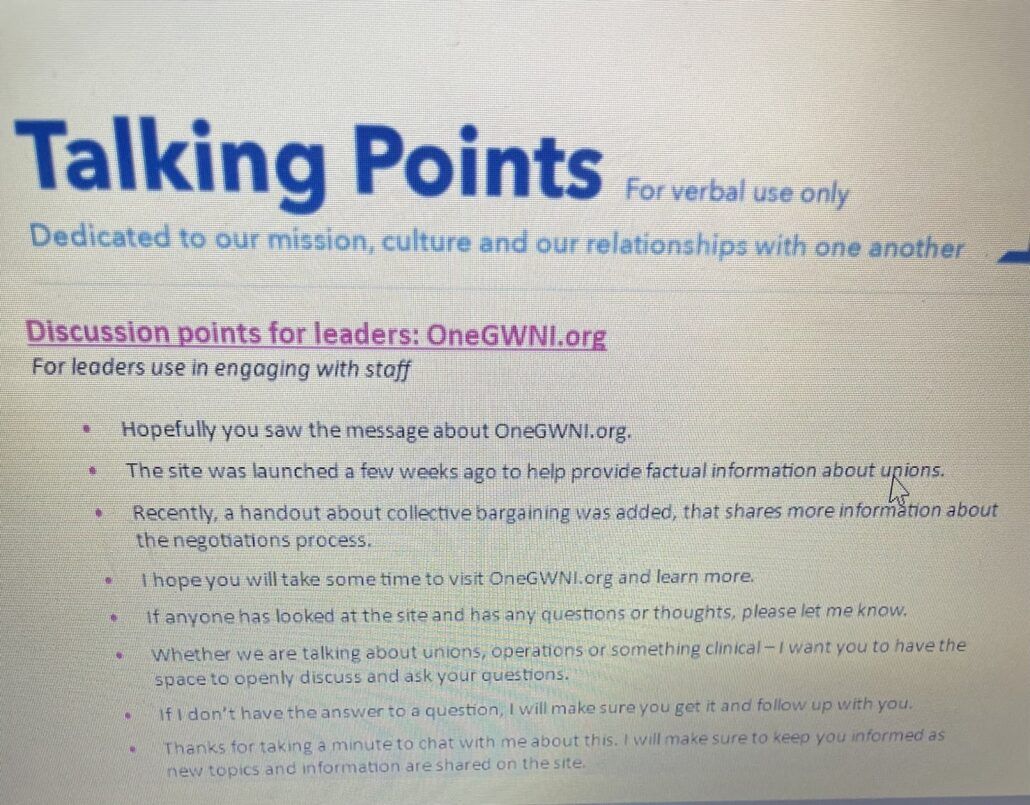
Mostly though, Alex was told to direct employees to an in-house website, OneGWNI.org, that had “fact sheets” about unions, frequently asked questions (with answers from PPGWNI’s leadership) and a way to theoretically ask the administration anonymous questions. Eastlund’s email to the staff about the new website stressed his support for “your right to engage or not engage in union activity,” and said the website was a “resource.”
The page is now password protected, but thanks to an internet archive and screenshots from current employees, we have reviewed the site. Some of the highlights include FAQs with an implicit anti-union bias, like:
- Can the union organizers come to my home/my families’ home/other places and find me?
- I signed a union authorization card, but I changed my mind. Can I get it back?
- How does a collective bargaining agreement change the flexibility we have?
- What happens if employees decide they no longer want to be represented by the union?
Some of the fact sheets highlighted very high estimates of how much an employee may be asked to pay in dues and the threat of “seniority in action.” Labor contracts are often governed by seniority, the fact sheet said, and seniority “can outweigh merit, overall experience and other factors often used to make important decisions.”
Posting about high union rates is a common union-busting technique to scare workers away. But according to info from UFCW3000’s website, union dues in our region come out to 1.55% of monthly gross income for members with a cap at $80 a month. A clinician making $80 an hour may have to pay that $80 a month payment, but medical assistants would pay much less.
Simon, the VP of Human Resources at PPGWNI, maintained that PPGWNI supported their employees’ rights to choose unionization or not, but did not comment on union-busting activities within PPGWNI or distributed materials. Their approach to employees considering unionization does not seem dissimilar to how “crisis pregnancy centers” handle people considering terminating a pregnancy: scare tactics and one-sided information designed to get them to act against their own interests.
Scroll this slideshow for the highlight reel of “necessary information,” Eastlund encouraged employees to read as they pondered unionization. (Click on each to enlarge and read):
These efforts must not have been enough, though. After a summer of pointing people toward internal resources, Eastlund entered into a contract with Labor Relations Institute — Corporate America’s favorite “union busters” — on Nov. 8 of this year.
Eastlund’s contract with LRI was “To persuade employees to exercise or not to exercise, or persuade employees as to the manner of exercising, the right to organize and bargain collectively through representatives of their own choosing.” This kind of vague, noncommittal language is commonly used in these kinds of contracts, partially because they are required by law to be filed with the National Labor Relations Board — the agency that regulates labor practices and unions, where they become public record.
On LRI’s website, the company speaks a different language. They offer free resources for “preventing unionization,” and paid services to help organizations “win the union vote — and ensure you never face one again.” In the footer of the website is a link that says, simply: “Avoid a Union.”
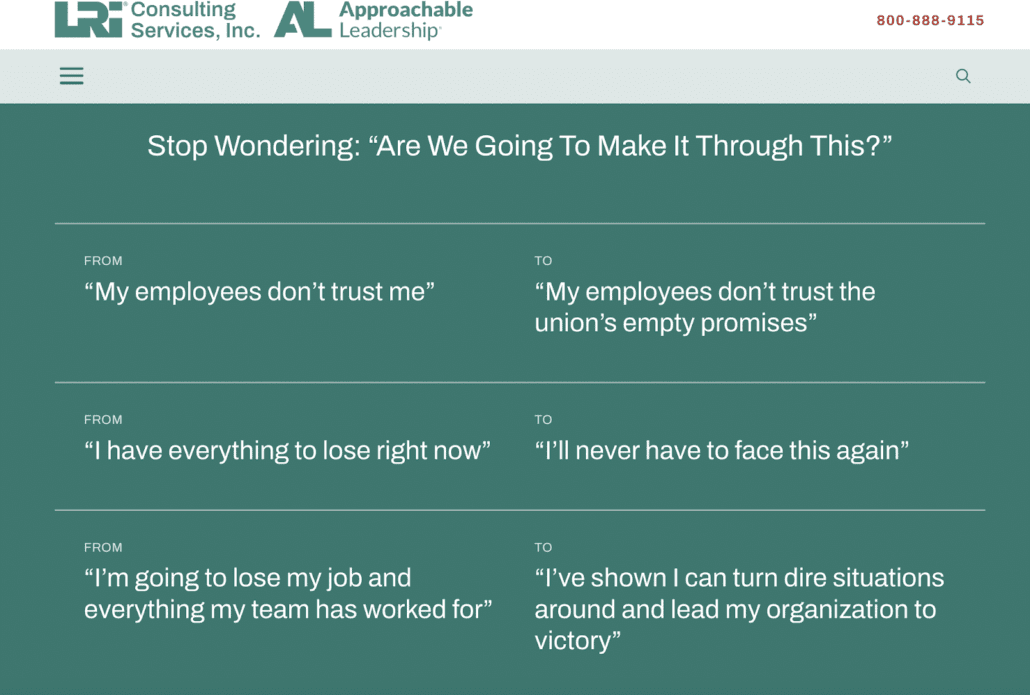
PPGWNI told RANGE they were focusing on preparations for “a hostile administration in 2025.” Meanwhile, LRI posted blogs and shared articles about how Donald Trump’s presidency could be “more employer-friendly,” reverse employee protections and kill pro-union precedents.
Here’s a gallery of their greatest hits (click on each to enlarge and read):
When asked about LRI’s services and their statements about Trump’s presidency, Simon from PPGWNI only wrote, “We believe employees have a right to make informed decisions when independently considering contractual agreements that could have an impact on their work environment. We felt it was important to respond to requests from staff who wanted more information. LRI provided an optional training for staff using materials provided by the National Labor Relations Board.”
LRI provided a quick, but polite, no comment. “We don’t have anyone who is going to talk to the media at this time, or really ever. You have a blessed day.”
The recent publication of the contract with LRI Consulting has shown employees a clear message: PPGWNI’s admin would rather pay $425 an hour to a union-busting firm than give hard-working employees raises or improve working conditions.
Elizabeth Hernandez, the subcontractor LRI hired for the campaign at PPGWNI, began her work with rank and file employees on Nov. 12 with three hour-long sessions. The single day she spent with staff cost PPGWNI $1,350.
“It was really disappointing hearing anti-union stuff from management,” Madeline said. “Planned Parenthood is supposed to be a completely neutral organization when it comes to unionizing, and that just has not even been close to the case with us.”
If unionization efforts fail, Madeline says she’ll leave her job and seek greener pastures. When she found out just how much PPGWNI was paying the union-busting firm, “It was such a slap in the face.”
Every paycheck, Madeline, like many other employees at PPGWNI, donates a portion of her income back to the organization, because she believes in the mission that much. “ Is that money that we pay because we believe in this cause and we believe in this mission being used to work against us in our best interests?” she wondered.
“They talk about wanting to save money and then they spend the paycheck of what is more than 10 medical assistants each hour [on LRI],” Madeline said. “It made me sick to my stomach, but not surprised.”
According to staffs’ explanations of the salary bands PPGWNI currently uses, medical assistants make between $17 and $25.50 an hour, so Madeline’s estimate is a little low: just one hour of LRI’s time could pay for an hour’s labor from between 17 and 25 medical assistants.
Additional reporting contributed by Luke Baumgarten.
This story was republished from RANGE Media, a worker-owned newsroom in Spokane. Read more of their coverage here.





